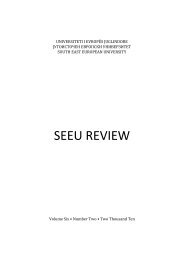SEEU Review vol. 5 Nr. 2 (pdf) - South East European University
SEEU Review vol. 5 Nr. 2 (pdf) - South East European University
SEEU Review vol. 5 Nr. 2 (pdf) - South East European University
You also want an ePaper? Increase the reach of your titles
YUMPU automatically turns print PDFs into web optimized ePapers that Google loves.
<strong>SEEU</strong> <strong>Review</strong> Volume 5, No. 2, 2009<br />
According to Eggleton (1992), motivating students is not a simple<br />
process, and it depends on the teacher’s individuality and methods of<br />
teaching. He states that the personality of a given teacher is the most difficult<br />
element of motivation to change. “The classroom environment can be one of<br />
the most demanding environments on individuals’ perceptions of their selfworth”<br />
(para. 3).<br />
Another author that views the role of teachers in a different way is Dewey<br />
(cited in Simpson, Jackson, & Aycock, 2005), who states that no matter how<br />
motivating the teachers are, they cannot learn for the students, but they can<br />
guide them and encourage them to study by engaging them in certain tasks.<br />
Since learning is something that the pupil has to do himself and for<br />
himself, the initiative lies with the learner. The teacher is a guide<br />
and director; he steers the boat but the energy that propels it must<br />
come from those who are learning (p.49).<br />
In summary, many scholars cited in this section agree that there are<br />
different types of motivation and that the teacher influences students’<br />
motivation. Whereas some authors identify the teacher as the most important<br />
influence, others state that the teacher is only the guide, and the rest of the<br />
responsibility lies with the learner.<br />
What do Scholars of Literacy Cite as Important Factors of<br />
Motivation in Education?<br />
According to Ambard and Ambard (2004), motivating students to use all<br />
four language skills (listening, speaking, reading and writing) is a key factor<br />
in a foreign language classroom. The role of motivation is seen as important<br />
in engaging students to read and use language skills as well, and according<br />
to Guthrie (2001), classroom circumstances are important in order to make<br />
students read. He presents the engagement model of reading development in<br />
which he includes motivation as one part of the model, together with strategy<br />
use, conceptual knowledge and social interactions. He sees motivation as the<br />
main contributor in children’s commitment to reading. Moreover, he states<br />
that motivation is many-sided and different; individuals possess different<br />
types of motivation within themselves. As a result, some of those types of<br />
motivation are more dominant than others.<br />
Gambrell (1996) states that motivation plays an important role in<br />
learning, and is very influential in helping to increase students’ willingness<br />
143

















